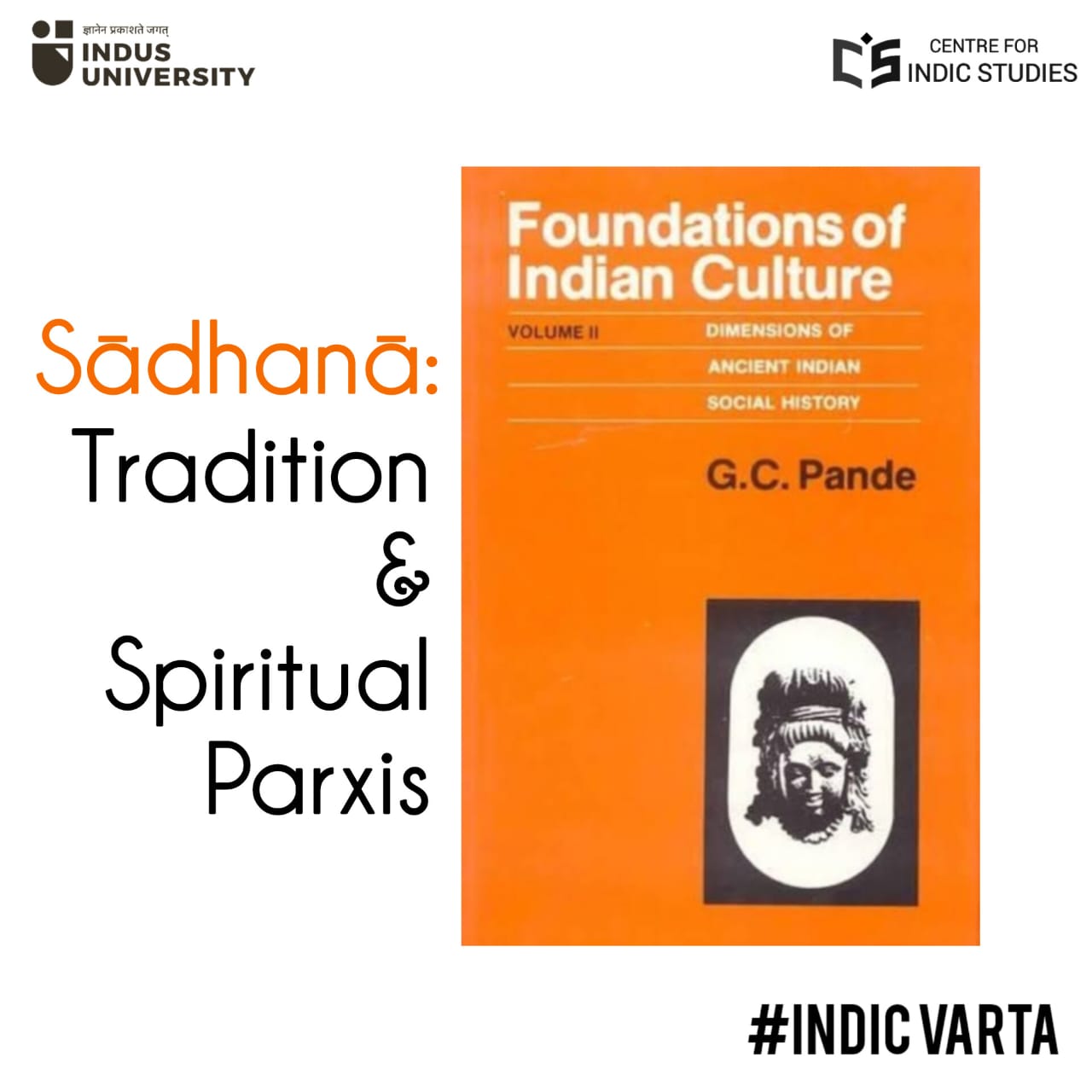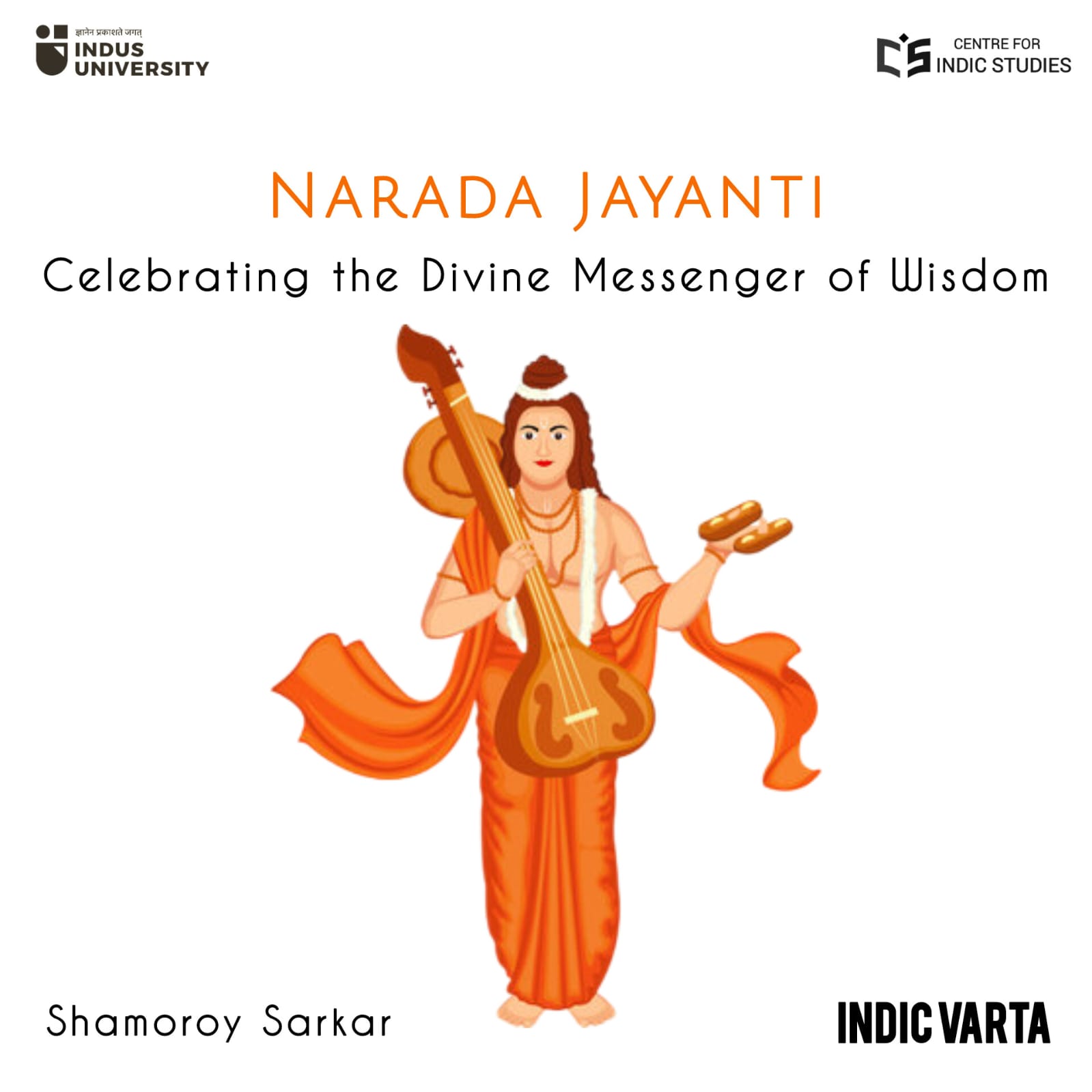- Visitor:21
- Published on: 2024-11-08 03:53 pm
Sādhanā: Tradition and Spiritual Praxis
Sādhanā is thus as extensive as life itself, expressing itself in the upward aspiration and effort organized as a deep and persistent point of view. It is not merely the ascetic and the mystic, the whole time religieux who is a sādhaka.

(An Excerpt from G. C. Pande's book: Foundations of Indian Culture)
Ultimate
spiritual authority in India is in practice held to belong not to ancient books
or their learned expositions, but to those who are believed to have personal
experience of spiritual truth. Spiritual truth is not held to be something
totally beyond the human ken, revealed once for all to some incarnation or
prophet of God. Nor is it something to which man can attain only in the life
after death. Spiritual truth is capable of being reached while a man yet lives;
this attainment of spiritual truth is profoundly different from its apprehension
in merely faith or philosophy. It is a living vision which transforms the inner
life, faculties and powers of the person who attains to it. Authority belongs
to one ‘who has attained’ (apta). The Vedic seer (ṛsi), the
enlightened one (buddha) or the perfected one (siddha) or the
worthy one (arhant) among the Buddhists or the Jainas, or the Adept (siddha)
among the tāntrika or the sant
in the bhakti schools, are all
variations of the same ideal figure. The process of seeking and obtaining
spiritual vision and inner transformation has been variously called, the
commonest expressions being sādhanā, or yoga.
It may
be felt that what has been described as sādhanā here is nothing
different from religious life or mystical practice. While it is true that all
moral or religious or mystical life could be subsumed within sādhanā, life
could be subsumed within sādhanā, the converse of this would not be
true. sādhanā is a term of greater generality and its use betokens the
perception of a continuity running through all human effort aiming at the
realization of higher values along with a sense of their gradation. Values are
undoubtedly relative to human needs and desires but they are equally the
objects of rational discrimination.
Behind
the diversity of limited needs and desires, running through them there is the
sense of a deeper and unending quest of which the object continually transforms
itself but continues to beckon like an ever renewing horizon. The true nature
of man is covered by a series of accidents or assumed personae. To each
of these corresponds a way of viewing the world and of seeking and valuing it.
The gamut of human experience runs from the inmost and highest level of purely
spiritual knowledge to the almost purely physical level of instinctive life.
Appropriately lived, life at each level is a preparation for transcending it,
as if a valve were to open upwards enabling a movement beyond the vortex below
it. This process of appropriate living and ascent to higher levels is sādhanā
yogah karmasuauśalam–– yoga is
skill in action. It is said yo vai bhūmā tatsukhaṃ nālpe sukhamasti–– infinity
alone satisfies. There is no satisfaction in what is limited. The Bhagavad Gītā
is the most explicit exposition of this and is the yogaśāstra par
excellence.
Sādhanā is
thus as extensive as life itself, expressing itself in the upward aspiration
and effort organized as a deep and persistent point of view. It is not merely
the ascetic and the mystic, the whole time religieux who is a sādhaka. A person engaged in his work in
any walk of life becomes a sādhaka by
adopting an attitude of detachment and dedication. The Mahābhārata
relates how a pious hunter Dharmavyādha instructs a brāhmāṇa ascetic. Similarly, the merchant Tulādhara gives
instruction to the ascetic Jājali. The Devī Bhāgavata shows us the king
Janaka to advantage over the famous mendicant Śuka. The tradition is widespread
and well accepted that the spiritual goal may be striven after in any kind of
social situation in the midst of any kind of life.
The Bhagavad
Gītā declares that a man ought to continue attending to the duties of his
station without even aspiring to change his station and status. As spoke Kṛṣṇa,
svakarmaṇā tam abhyarcya siddhiṁ vindati mānavaḥ––man obtains perfection
by worshipping him with his own work. As ordinarily understood, religion is
only a part of life; whereas sādhanā embracing the whole of life may be
described as a non-dogmatic, universal religion of man coterminous with life in
so far as it seeks spiritual elevation. The standpoint of sādhanā
recognizes the pervasive unity of human spiritual efforts in the midst of the
most diverse conditions of existence. On the other hand, it recognizes that
corresponding to the differences of the individual temperament, social
situation and cultural tradition, men may engage in the most diverse practices
and ways of living seeking to elevate themselves spirituality.
“Rucīnām
Vaicitryādṛjukutilanānāpathajuṣāṃ”–– Just as different rivers flow towards
the same ocean, so with their diverse tastes and inclinations do men approach
the Lord. “Vineya-bhedāt deśānā-bhedaḥ”–– teaching differs according
to the individuality of the recipients. This catholicity not only tolerates
moral and religious differences; it discovers a rationale for such diversity.
It rejects the notion that there is one true religion, a single spiritual straight-jacket.
Contrary to the religious monolithism and consequent conflict which have
prevailed in the western world from ancient times, India has upheld through the
ages the free dissemination and commingling of different creeds and sects.
Saints of whatever religion receive the same respect from the people
irrespective of their creed. It took centuries of bloodshed and repeated
holocausts to enable the west effect a distinction between religion and
politics, without however wholly eradicating the seeking after ideological
uniformity.
The Western
concept of secularism merely refused to support religion by political force.
Transported to India even the concept of secularism has come to be interpreted
not merely as the religious neutrality of the state, but as the catholicity of
multi-religious culture, not dharma-nirapekṣatā but sarvadharmasamabhāva.
Efforts are sometimes made to question this broad-minded tolerance and to
belittle it as the result of a lack of earnestness or as merely confused
syncretism. Doubtless, in the long history of India there have been episodes of
intolerance and with the intrusion of the Semitic tradition occasionally bloody
conflicts: nevertheless, the difference in this respect the histories of India
and of the West can hardly be missed by any impartial observer.
As far
as the argument from religious earnestness is concerned, it mistakes the actual
situation in India. The different schools and sects neither give quarter,
ideologically speaking, nor expect it. The fiercest controversies and debates
have raged among the followers of different schools and sects. At the same
time, they admit the equal right of others to practice their own beliefs, and
it was abhorrent to them to seek to gain converts for themselves by force.
There was no lack of earnestness, but there was a counter-balancing recognition
of the diversity of men and their ways.
It was
fully realized that in some sense sādhanā constitutes a universal and a
unique path or process. It says: “anyaḥ panthāḥ na vidyate”, there is no
other path for, treading “ekāyano ayaṃ bhikkhave maggo”––O monks this
is the only way.
The
recognition of a single universal spiritual process follows from the basic
spirituality of human nature and the unity of its ultimate goal. Nevertheless,
it has to be recognized that what divides man from his goal is a
differentiating factor and varies from man to man. The human condition is an
individualized condition, and consequently there is an individual way for
everyone to emerge from his shell or historically constructed psychic scenario
into the royal highway of spiritual life. From the ‘house’ to the ‘high way’
everyone must construct his own path joining other pilgrims at different points
and tending to identify the highway with their path. In a way every pilgrim
feels himself a lonely wayfarer: in another he feels himself incomplete.
Tradition, holy books, teachers, prescriptions and ritual, symbols and maps of
the journey, all these give one confidence and assurance that he is not alone,
that he has the weight and support of others behind him.
This
attitude can easily degenerate into an over-reliance which confuse symbolism
with description, spiritual inspiration with magical communion, or into a
narrow-minded attitude which confounds a particular tradition with an only
permissible spiritual fellowship.
- 10 min read
- 1
- 0










